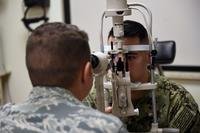 MILITARY UPDATE: Congress: We Went Too Far on Star-Rank Retired Pay
MILITARY UPDATE: Congress: We Went Too Far on Star-Rank Retired Pay
At the urging of then-Defense Secretary Donald Rumsfeld, Congress in 2006 took aggressive steps to raise pay and future retirement of currently serving general and admirals, particularly those serving beyond 30 years.
Having been a well-compensated industry executive, Rumsfeld viewed admirals and generals as underpaid. Besides raising star-rank pay, he wanted the military basic pay table expanded to incentivize longer service.
He got what he wanted, and maybe more. In September 2006, a newly retired member of the Joint Chiefs of Staff who served 38 years drew initial retired pay of $114,000 a year. Today a JCS member retiring after 38 years draws more than double that amount, roughly $241,000. If that four-star officer completes a 40-year career, his or her retired pay today would be higher. Four officers today receive more than $256,000 in retired pay and one get more than $277,000, according to the Defense Department actuary.
The fact is generals and admirals recently have been enjoying a kind of golden age of star-rank compensation, shaped in wartime and not likely to be seen again, particularly given a change in law that takes effect Jan. 1.
Star-rank officers won’t get a 2015 pay raise. More significantly, any additional years they serve won’t have the hefty consequences on retired pay seen since 2006. Star-rank annuities jumped so far and fast that recently retired three-star and four-star officers now make considerably more in retired pay than did while on active duty. That’s true even counting housing allowance of about $40,000 annually or, more often, the comparable value of residing in three-star and four-star base housing.
Congress included in the fiscal 2015 Defense Authorization Act a provision that phases out a “too generous” retired pay anomaly gradually, fully protecting the pay of senior officers already retired and easing the impact too on currently serving officers who already wear stars.
The universe of three- and four-star officers drawing more pay in retirement than they did on active duty is small, roughly 130. But the pay disparity is large, $70,000 or more for some 0-9s and 0-10s above what they received in basic pay while on active duty. To understand why, we need to look at all of the levers Congress pulled seven years ago:
RETIRED PAY MUTIPLIER – Before 2007, service members received no retirement credit for years served beyond 30. The multiplier for calculating retired pay was still 2.5 percent of basic pay per year served but the years were capped at 30, capping retirement at 75 percent of basic pay.
Effective Jan. 1, 2007, the 30-year cap was lifted for retirements on or after that date. Service members who stayed beyond 30 could continue to earn 2.5 percent of basic pay toward retirement, all the way to 40 years where annuities top out at 100 percent of basic pay.
40-YEAR PAY TABLE – On April 1, 2007, a 40-year pay table went into effect, adding new “longevity” steps in basic pay for officers O-6 and above, warrant officers in grades 4 and 5, and enlisted E-8s and E-9s. Longer-serving O-8s saw two new longevity raises at 30 and 34 years. E-9s, W-5s, O-9s and O-10s saw three, at 30, 34 and 38 years. So for longer careers, the combination of higher retired pay multipliers and added longevity raises led to far more generous retirements.
EXECUTIVE PAY CAP LIFTED – Before 2007, basic pay for generals and admirals could not exceed Executive Level III pay for federal civilians. Even with retired pay limited by the 75 percent multiplier, this executive level pay cap led to a dampening of star-rank annuities.
Congress raised that cap to Executive Level II on Jan. 1, 2007, which lifted basic pay for senior officers sharply. Today that change alone adds more than $14,600 to senior officer pay. But then Congress granted one more big favor. It changed the law so that the executive level pay cap is ignored in calculating retired pay of flag and general officers.
The effect of all of these changes was huge. A member of the Joint Chief who retired in April 2007 with 38 years service began drawing retired pay 83 percent higher than the JCS member who retired after 38 years in September 2006 or earlier. Four-star retired pay popped by $95,000.
Longer serving enlisted members also benefited, at least from the 40-year pay chart and expanded retired pay multiplier. An E-9 retiring in April 2007 after 38 years drew 53 percent more retired pay than a colleague of equal grade and longevity who retired seven months earlier.
Congress never expressed a regret about the generous star-rank retirement it voted until last January. During a Senate Armed Services Committee hearing on the COLA-minus-1 fiasco, when Congress rushed to cut the value of military retirement then quickly reversed itself, Sen. Kelly Ayotte (R-N.H.) referred to a news article. Today’s highest-ranking officers, she said quoting from the piece, could earn more military compensation in retirement than they did while on active duty.
Wasn’t that a negative incentive to continue to serve, she asked.
The committee found no proof that it was. However, it didn’t seem right that retired pay exceeded active duty compensation by a wide margin. So senators included language in the 2015 defense bill (HR 3979) that restores the Executive Level II cap on retired pay calculations.
The change is designed to land softly, however. It applies only to years served after 2014.
“That means if you’ve earned above the cap up until this point, you can keep that but go no higher,” explained one congressional aide. “And if you retired before Dec. 31, 2014, this doesn’t even apply.”
So finance centers will conduct two computations to determine retired pay of senior officers serving today and will use the one that delivers higher annuities. One calculation will be retired pay based on current law and rank at retirement, capped at Executive Level II, which is $183,300 for 2015.
A second will determine the retired pay that these officers would have if they retired on Dec. 31, 2014, at the rank then held and years then served. The second calculation will protect a lot of retired pay at first, and become less important over time. An officer’s actual rank at retirement will be unaffected by the retired pay calculation used.
To comment, e-mail milupdate@aol.com, write to Military Update, P.O. Box 231111, Centreville, VA, 20120-1111 or visit: www.militaryupdate.com
# # # # #
Tom Philpott has been breaking news for and about military people since 1977. After service in the Coast Guard, and 17 years as a reporter and senior editor with Army Times Publishing Company, Tom launched "Military Update," his syndicated weekly news column, in 1994. "Military Update" features timely news and analysis on issues affecting active duty members, reservists, retirees and their families.
Visit Tom Philpott's Military Update Archive to view his past articles.
Tom also edits a reader reaction column, "Military Forum." The online "home" for both features is Military.com.
 Tom's freelance articles have appeared in numerous magazines including The New Yorker, Reader's Digest and Washingtonian. His critically-acclaimed book, Glory Denied, on the extraordinary ordeal and heroism of Col. Floyd "Jim" Thompson, the longest-held prisoner of war in American history, is available in hardcover and paperback.
Tom's freelance articles have appeared in numerous magazines including The New Yorker, Reader's Digest and Washingtonian. His critically-acclaimed book, Glory Denied, on the extraordinary ordeal and heroism of Col. Floyd "Jim" Thompson, the longest-held prisoner of war in American history, is available in hardcover and paperback.



